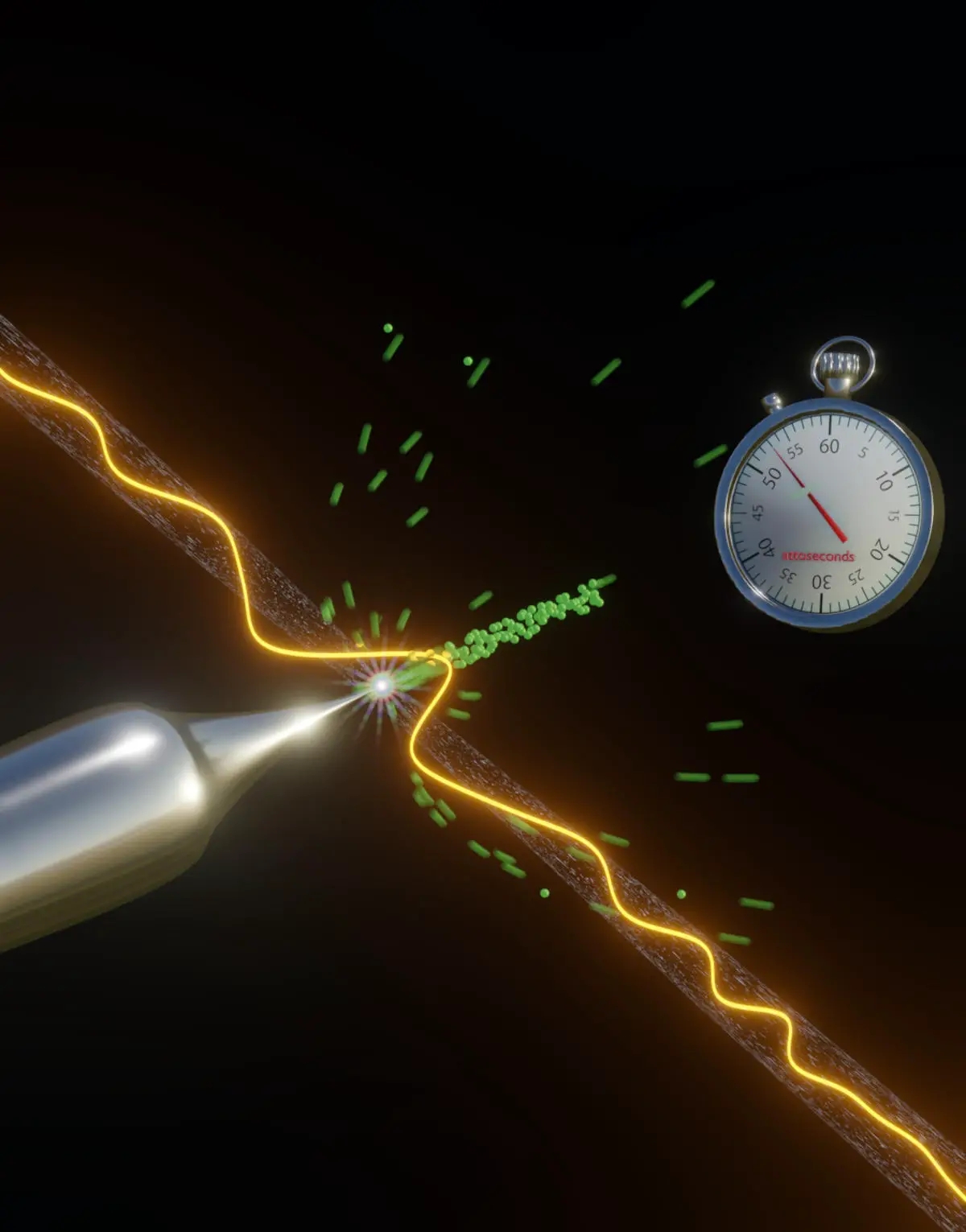博文
《自然》:电子学突破——科学家产生了最短的电子爆发
||
《自然》:电子学突破——科学家产生了最短的电子爆发
诸平

据德国罗斯托克大学(Universität Rostock / University of Rostock, Germany)2023年2月24日提供的消息,电子学突破:科学家产生了最短的电子爆发(Electronics Breakthrough: Scientists Generate Shortest Electron Burst Yet)。
您是否曾想知道为什么您的电脑和其他电子设备有时运行快速,有时运行缓慢?这一切都归结为电子——微观世界中最小的粒子——从电子芯片晶体管中的微小引线流出并产生脉冲的速度。开发提高这种速度的方法对于推动电子产品及其应用发挥最大性能潜力至关重要。
但是,电子从电子电路中的微小金属引线流出的最短时间是多少?
罗斯托克大学物理研究所极端光子学研究组(Extreme Photonics of the Institute for Physics at the University of Rostock)的负责人埃莱夫塞里奥斯·古利尔马基斯(Eleftherios Gulielmakis)教授和德国斯图加特的马克斯·普朗克固体研究所(Max Planck Institute of Solid State Research in Stuttgart)的合作者领导的一组研究人员,使用极短的激光闪光的一项研究,他们使用了最先进的激光脉冲从钨纳米尖端(tungsten nanotip)发射电子,并产生了迄今为止最短的电子爆发(shortest electron burst)。这一发现于2023年1月25日已经在《自然》(Nature)杂志网站发表——H Y Kim, M Garg, S Mandal, L Seiffert, T Fennel, E Goulielmakis. Attosecond field emission. Nature, 2023, 613(7945): 662-666. DOI: 10.1038/s41586-022-05577-1. Epub 2023 Jan 25. https://www.nature.com/articles/s41586-022-05577-1
尽管人们早就知道光可以从金属中释放电子,爱因斯坦(Einstein)是第一个解释了如何释放电子(光电效应)的人,但这一过程极难控制。光的电场每秒钟改变方向约100万亿次,这使得控制它从金属表面撕除电子的方式变得非常困难。
为了克服这一挑战,罗斯托克大学的科学家和他们的同事使用了一项在他们小组中早期开发的现代光场合成(light field synthesis)技术,该技术可以缩短光场闪光的时间,使其小于自身光场的全速摆动。然后,他们用这些闪光照亮钨针尖,将电子释放到真空中。
“利用只包含一个光场周期光脉冲,现在就有可能对电子进行精确控制,在很短的时间间隔内使电子脱离钨尖端,”该研究小组的负责人埃莱夫塞里奥斯·古利尔马基斯解释道。
但是,除非科学家们也找到一种方法来测量这些电子爆发的短暂性,否则这一挑战将无法克服。为了解决这一难题,研究小组开发了一种新型的照相机,它可以在激光将电子从纳米尖端推入真空的短时间内拍摄电子的快照。
这项新研究的主要作者Hee-Yong Kim博士说:“技巧是使用第二道非常微弱的闪光,这第二道激光闪光可以轻微地干扰电子爆发的能量,以了解它在时间上的变化。”他继续说道,“这就像一个游戏‘盒子里装的是什么?’玩家试图在不看物体的情况下识别物体。而是通过转动它,用手来感受其形状。”
但是,这项技术如何应用于电子产品呢?“随着技术的飞速发展,人们有理由期待微型电子电路的发展,在这种电路中,电子在紧密排列的导线之间的真空空间中传输,以防止阻碍它们的运行,”埃莱夫塞里奥斯·古利尔马基斯说。“利用光发射电子并驱动电子在这些引线之间穿梭,未来的电子器件的性能可以提高数千倍”,他进一步解释道。
但是研究人员相信他们新开发的方法将直接用于科学目的。“在光场周期的一小部分内从金属中射出电子极大地简化了实验,并使我们能够使用先进的理论方法来了解电子发射的方式,这是以前不可能的。”新论文的合著者之一托马斯·芬内尔(Thomas Fennel)教授说。
“由于我们的电子爆发为拍摄材料中的电子和原子运动提供了极好的分辨率,我们计划利用它们来加深对复杂材料的了解,从而促进其在技术上的应用,”埃莱夫塞里奥斯·古利尔马基斯总结道。
本研究得到了德国研究基金会(Deutsche Forschungsgemeinschaft简称DFG / German Research Foundation) SFB 1477界面上的光-物质相互作用项目(DFG / German Research Foundation SFB 1477 ‘Light-Matter Interactions at Interfaces’, project number 441234705)的支持。
上述介绍,仅供参考。欲了解更多信息,敬请注意浏览原文或者相关报道。
Field emission of electrons underlies great advances in science and technology, ranging from signal processing at ever higher frequencies1 to imaging of the atomic-scale structure of matter2 with picometre resolution. The advancing of electron microscopy techniques to enable the complete visualization of matter on the native spatial (picometre) and temporal (attosecond) scales of electron dynamics calls for techniques that can confine and examine the field emission on sub-femtosecond time intervals. Intense laser pulses have paved the way to this end3,4 by demonstrating femtosecond confinement5,6 and sub-optical cycle control7,8 of the optical field emission9 from nanostructured metals. Yet the measurement of attosecond electron pulses has remained elusive. We used intense, sub-cycle light transients to induce optical field emission of electron pulses from tungsten nanotips and a weak replica of the same transient to directly investigate the emission dynamics in real time. Access to the temporal properties of the electron pulses rescattering off the tip surface, including the duration τ = (53 as ± 5 as) and chirp, and the direct exploration of nanoscale near fields open new prospects for research and applications at the interface of attosecond physics and nano-optics.
https://blog.sciencenet.cn/blog-212210-1377915.html
上一篇:科学家发现新的超强酸
下一篇:《自然能源》:新的研究密切关注能量储存